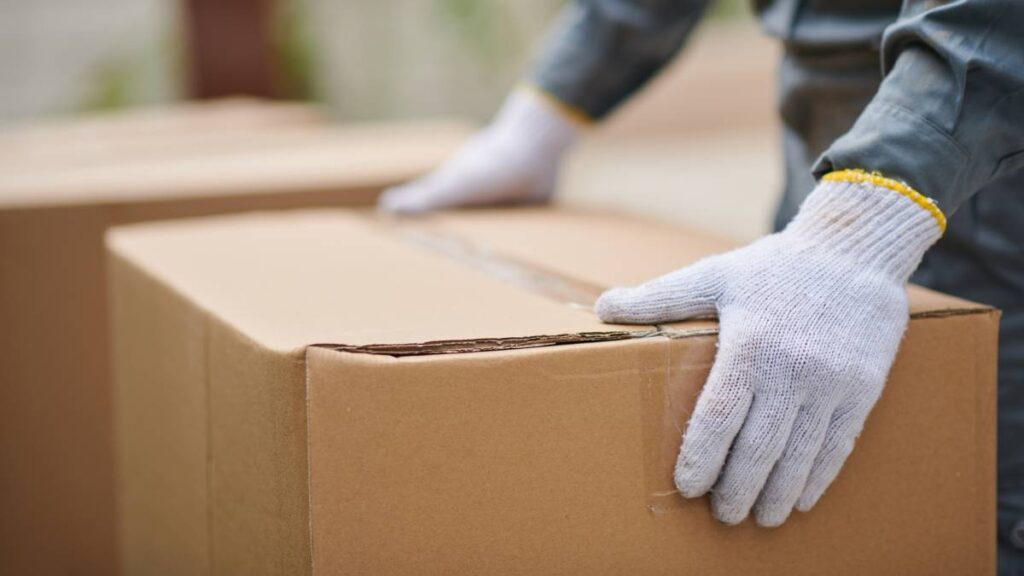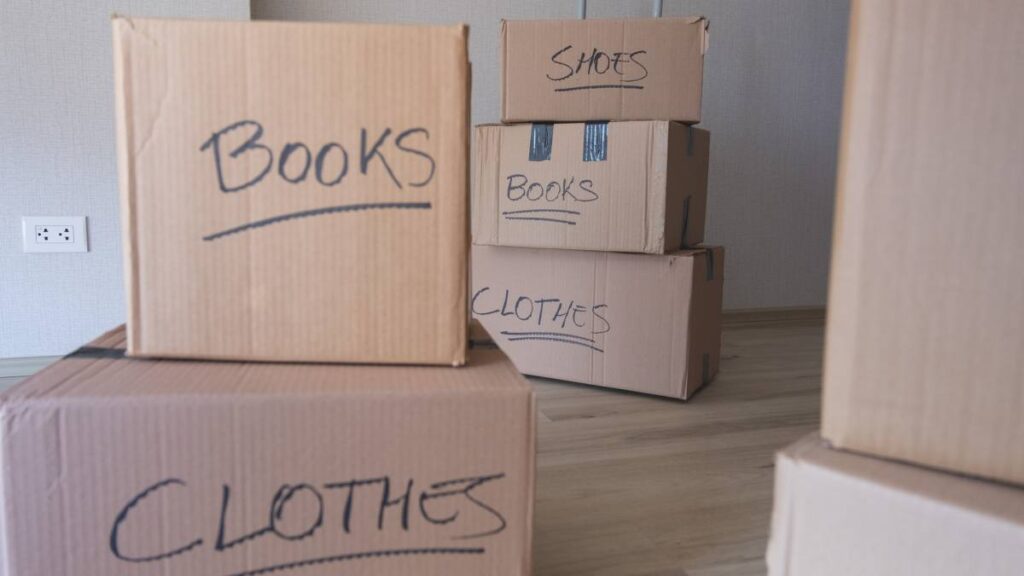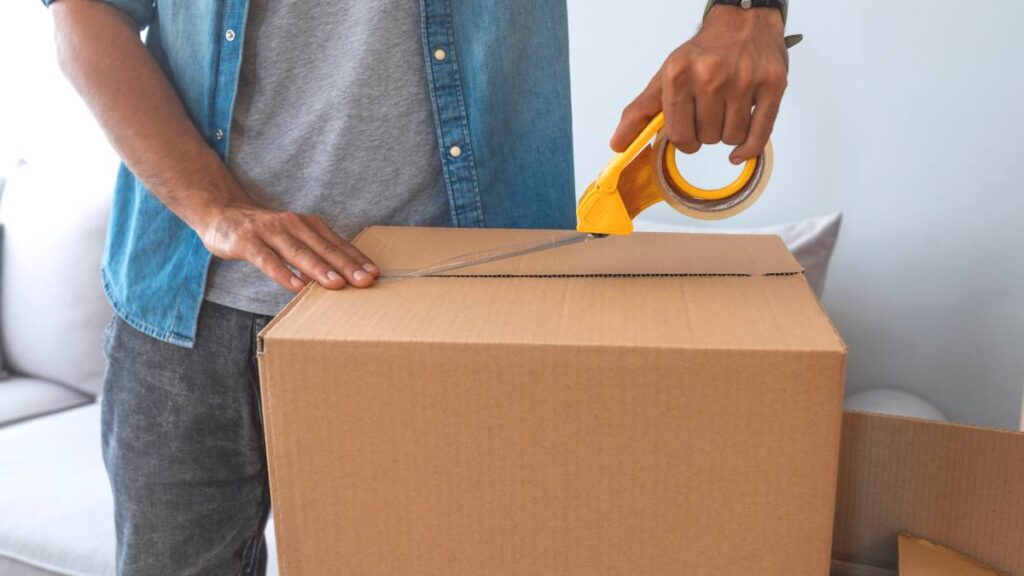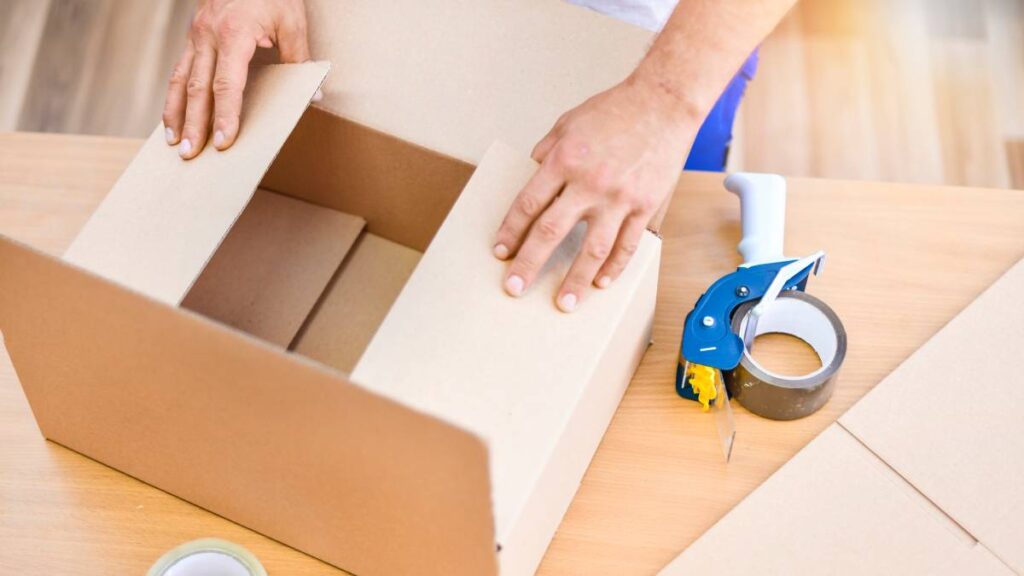| Key takeaways: • Check with people you know, online marketplaces, and within your community for moving boxes you could use and get for free. • Inspect your moving boxes and reinforce the seams and the base for sturdier hold. • Look into plastic crates you could rent if you want solid boxes or containers for your belongings. |
Moving house is stressful enough without adding extra costs to the process. Between removalist fees, storage, and packing supplies, expenses pile up quickly. The good news is that you don’t always need to buy them. You can find plenty of options for inexpensive moving boxes as long as you know where to look and ask.
This guide walks you through where to find free moving boxes, how to judge box quality, and the best ways to prepare them for moving day. By the end, you’ll know how to save money while still keeping your belongings secure.
What makes a good quality moving box?

Before you start collecting boxes, it helps to know what makes one reliable. A free box that collapses under weight is no bargain at all. Here are the four key considerations for choosing reliable moving boxes:
Durability and strength
- Double-walled vs. Single-walled: Choose double-walled cartons for heavy items like books and tools. Reserve single-wall options for lighter belongings.
- The feel test: A sturdy box should feel rigid when you run your hand along the sides. Avoid those that bend or crumple under light pressure.
Size and weight distribution
- Small boxes: Best for dense, heavy items like books, tinned goods, or tools. This prevents the box from being overloaded.
- Medium boxes: Ideal for everyday household goods, kitchenware, pantry supplies, or shoes.
- Large boxes: Reserve these only for lightweight, bulky items such as bedding, cushions, or lampshades. Never fill large boxes with heavy goods, as this risks injury and breakage.
Condition
- Damaged boxes: Don’t use any boxes that are water-stained, torn, or have sagging seams.
- Odour: Avoid boxes that smell musty, as moisture weakens the cardboard structure, making them unreliable when stacked.
- Specialty boxes: Look for specialty cartons for fragile items, like flat boxes, which are designed for moving large, flat items like televisions, mirrors, or artwork.
In cities like Sydney, Melbourne, or Adelaide, retailers often stock commercial-grade cartons; asking about moving boxes from Adelaide suppliers can lead you to higher-quality options than generic alternatives.
Types of free moving boxes to look out for

Not all cartons are made equal! When you’re wondering where to find boxes for moving for free, remember that some are designed for fragile items, others for bulky loads, and some for heavy everyday goods.
These are the most common types and how to use them effectively:
- Television box – Made to fit flat-screen TVs securely, usually with foam inserts or rigid side panels. Choose a box close to your TV’s screen size to stop movement inside. Always use corner protectors and keep the original packaging if possible. Many retailers or appliance stores will give away spare TV cartons if you ask soon after deliveries.
- Glassware box – Designed with cardboard dividers or cells that separate each glass. They’re excellent for wine glasses, beer steins, or fragile mugs. Use tissue or butchers’ paper to wrap stems before placing them in the cells for extra padding. Liquor stores often discard sturdy cartons with dividers, which can substitute for glassware boxes if you reinforce them with tape.
- Dishware box – Strong cartons with sections that hold plates vertically rather than stacked flat. This positioning reduces pressure and makes chipping less likely.
- Box for pictures and mirrors – Flat, elongated boxes that keep frames, mirrors, and canvases upright. Choose a box slightly larger than the item so you can pad the sides with bubble wrap or foam. Never place multiple frames in one box unless separated with firm padding. Many framing shops will supply flat boxes or cardboard sheets if you ask.
- Large boxes (45 x 45 x 60 cm) – Ideal for lightweight, bulky goods like bedding, doonas, pillows, lamps, or kitchen appliances. Avoid overfilling with heavy items, as these cartons can split or be unsafe to lift. Storage suppliers sell these in multi-packs, but some furniture or bedding stores may give them away after stock deliveries.
- Medium-sized boxes (45 x 45 x 40 cm) – Often called the “workhorse” of moving boxes, medium cartons are sturdy and versatile. They work well for books, pantry items, clothing, or shoes. These are the most common size you can get in bundles.
- Small boxes – Compact cartons that stay strong even when filled with dense goods. Use them for cutlery, utensils, chargers, cables, small appliances, or decorative ornaments. They’re also useful for toiletries or cleaning products, as leaks are contained. Liquor cartons, shoe boxes, and fruit boxes from supermarkets are excellent free substitutes.
Where to get free moving boxes in Australia

Finding cartons at no cost can save you hundreds of dollars. The key is knowing where to find cardboard boxes for free and how to ask. Here are the most reliable places to start:
Friends, family, neighbourhood
One of the easiest ways to collect moving boxes for cheap is by asking people you already know. Friends or neighbours may have leftover boxes from online deliveries or past moves. A quick message in a group chat or local noticeboard often produces results, especially if you make it easy by offering to pick them up at a convenient time.
Online marketplaces
Social platforms are full of people giving away moving boxes. Facebook Marketplace, Buy Nothing groups, Freecycle, and Gumtree’s free listings often feature cartons in cheap boxes for moving in excellent condition.
Set up alerts for your suburb so you can respond quickly; these posts are often claimed within hours. Metropolitan areas see particularly high turnover on these platforms, so searching for cheap moving boxes in Melbourne groups can yield results within the same day. And when asking, keep your request short and specific, such as “Looking for 10–15 medium moving boxes; can collect after 6 pm.”
Local retailers and supermarkets
Shops receive large quantities of stock daily and often discard strong cartons. A supermarket is usually the best place to get moving boxes for free; they typically have banana boxes, which are sturdy and easy to stack, while liquor stores regularly recycle wine cartons with built-in dividers that are perfect for glasses.
The best time to ask is just after deliveries, either early morning or late evening. Speak to the staff politely and see if they can set some aside for you.
Garage sales and community markets
Here’s where to get free packing boxes: markets and garage sales often leave sellers with piles of empty boxes once the day ends. Arriving near closing time and offering to take cartons off their hands is an easy way to collect a variety of sizes.
Many stallholders would be willing to give them away, saving them the effort of disposal. Make sure to bring tape and a trolley to reinforce and transport them on the spot.
Recycling centres
Wondering how to get moving boxes for cheap? Some recycling centres allow residents to collect intact cartons before they’re compacted. Always call ahead to check local policies, as rules vary between councils. Be selective; only take boxes that are dry, firm, and free from stains. It’s also wise to reinforce these with tape before using them for fragile items.
Local removalist service providers
Removalist companies often have leftover boxes from previous jobs. Many will sell them at a discount or even give them away if they’re still in good condition. Calling around to local companies can save money while also letting you compare removalist costs if you’re planning to book help.
Schools, libraries, offices
Institutions like schools and libraries discard cartons during term breaks or when new stock arrives. Offices also throw out large quantities during cleanouts. Contacting admin staff ahead of these times can secure strong, uniform cartons. Some facilities may even let you use loading docks to make collection easier.
Where to get cheap moving boxes

If free boxes don’t cover all your needs, there are plenty of inexpensive moving boxes you could look into.
Renting
Renting plastic crates is increasingly popular, with many companies providing sturdy, reusable crates delivered to your door. Some companies charge by individual crate per week—delivery and pickup included—but many bundle their packages based on how big the move is.
Bulk suppliers and wholesalers
For those wondering where they can buy cheap moving boxes, bulk suppliers are a cost-effective choice. Carton suppliers sell various sizes of cartons in packs and might even buy them back if returned in good condition. These wholesalers often provide discounted bundles or moving packs, which can bring down the average cost per box.
Retail stores and storage centres
Even storage centres and hardware chains stock moving cartons. Some charge delivery fees for online orders, so compare costs with local pickup. When buying in bulk, the difference of a few cents per box can add up quickly. Major suppliers of moving boxes in Sydney typically maintain larger inventories, making it easier to find bulk deals.
Checking and preparing your boxes for moving

Even sturdy cartons need a quick check before you fill them. Taking a few minutes to prepare boxes properly reduces the chance of collapse and keeps your belongings secure during transit. A well-prepared box also makes moving easier for you and your removalists, especially if you’re moving interstate.
- Inspect for strength – Look for water stains, soft spots, or sagging walls. A musty smell often signals damp damage. Reject boxes with mould, pests, or crushed corners.
- Reinforce weak boxes – Use strong packing tape to secure seams, especially along the base. Replace bottom flaps if they don’t close tightly, or overlap them for extra support.
- Test weight limits – Keep small cartons under 12 kg, medium cartons under 20 kg, and use large boxes only for light goods like linen or cushions. Overloaded boxes are difficult to carry and may split in transit.
- Stack-test before moving – Load a box with a few items, place another on top for 30 seconds, and check for bowing. If the base gives way, use that box only for light items.
- Line fragile cartons – Add a layer of butchers’ paper, bubble wrap, or foam along the sides and bottom before packing crockery, glassware, or electronics. This protects against shocks during loading.
- Seal properly – Use the “H” method. Place two strips of tape along the seam and one across the flaps. For heavy cartons, add a third strip for extra strength.
- Label clearly – Mark cartons with the destination room and handling notes like “Fragile” or “This Side Up” on at least two sides. It helps removalists stack correctly and speeds up unpacking.
- Do a mid-pack safety check – Once you’ve filled and sealed a box, gently press or nudge it while stacked. If there’s give, redistribute the weight or add reinforcement before moving day.
Get ready to pack
You don’t need to overspend on packing supplies. By simply asking here and there, you can collect sturdy free cartons from community groups, retailers, and neighbours, or choose cheap options from bulk suppliers and crate hire services. By preparing and reinforcing boxes properly, you’ll keep your belongings safe and avoid stress on moving day.
When you’re ready to take the next step, compare quotes from trusted professionals. You can find qualified and expert removalists on Oneflare who can handle the packing and transport for you, allowing you to focus on other important moving tasks.
FAQs on moving boxes
Can I reuse cardboard boxes safely when moving house?
Yes, provided they are dry, structurally sound, and free of pests. Avoid reusing food cartons for fragile items unless reinforced. Always check for water damage, soft seams, or signs of wear before trusting them with valuable belongings.
What’s cheaper: buying cardboard boxes or hiring reusable crates?
For short moves, crate hire is usually more economical. For example, crate rental companies charge roughly $130+ for twenty-five crates for one week, while buying the same number of new cartons at, say, $3.50 each would cost about $88.
Add in the time and cost of disposing of cardboard afterwards, and crates often come out ahead for short timelines. If you need boxes for longer than three months, buying is generally cheaper.
How many moving boxes do I need for a 2-bedroom house in Australia?
On average, about thirty-five cartons are enough: twenty medium, ten small, and five large. Add specialty cartons as needed for wardrobes and electronics.
When is the best time to ask shops for free cardboard boxes?
Early morning and late evening, right after stock deliveries, are the most reliable times. Staff often have surplus cartons they’re happy to set aside if you ask politely.
What should I check before reusing old moving boxes?
Make sure they are dry, free of mould, and smell neutral. Check seams and corners for strength. Avoid anything with water stains, rodent damage, or sagging panels.